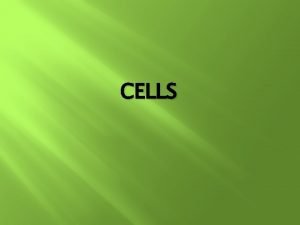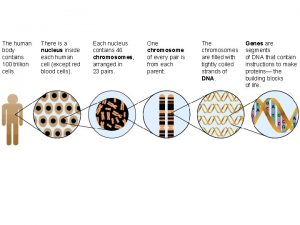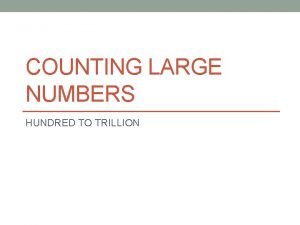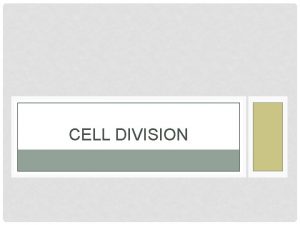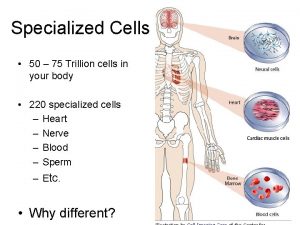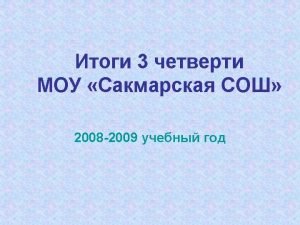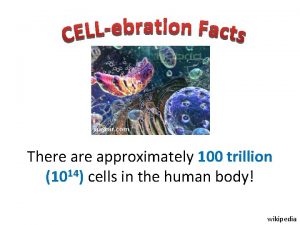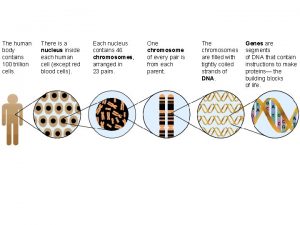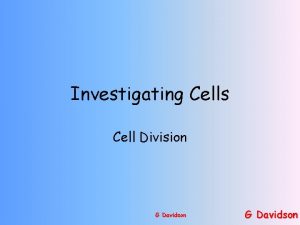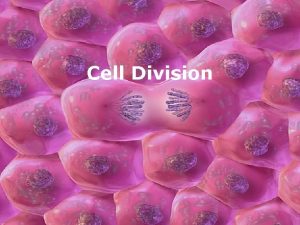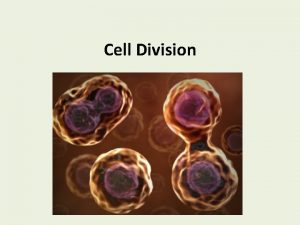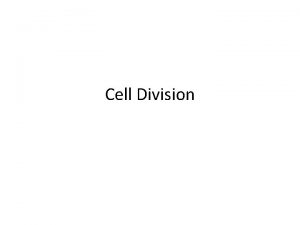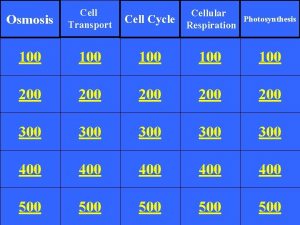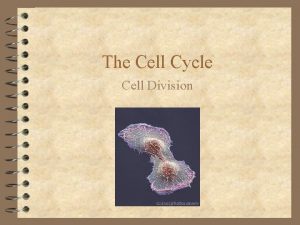Cell Division The 100 trillion cells of your



















- Slides: 19


Cell Division • The 100 trillion cells of your body are truly amazing, when you think that they all started from a single, fertilized egg. They stand as proof of the ability of human cells to reproduce grow ______ and __________.

• Reproduction generally means to make a copy ______ of something. Human reproduction, specifically, is a natural process where humans produce more humans. But, before we get too ahead of ourselves, we must start with the basics…

The Cell • The cell is the basic unit life. All living _________ organisms are made up of them. Some organisms are made up of a single cell, while others are made up of trillions of cells, like humans.

• Cells hold all of the equipment necessary to keep an organism alive. Cells must divide _________ to make new cells or the organism would die. There are two types of cells: Animal cells 1. ________ 2. ________ Plant cells Just like humans have organs to keep them alive, cells have __________ to organelles carry out all of their life processes.

Cell Division • As previously stated, human bodies contain trillions of cells. How did we go from a single cell to an entire person with skin, bones, and organs? Our cells had to divide over and over again.

Why do cells need to divide? • • Healing/repair Growth Replacing dead cells Reproduction

Cell Cycle pre-existing • All cells come from ___________ cells. Any new cell must come from another cell through the process of reproduction. Cells needed for repair, growth, or the maintenance of a species must use cell division.

• Cells live through a sequence of three steps called the cell cycle. The three stages are: 1. Interphase 2. Mitosis 3. Cytokinesis

1. Interphase • Before mitosis, during interphase, the cell identical set of its creates an ______ chromosomes. 46 92

1. Interphase • At the beginning of mitosis the chromosomes wind up into visible objects that can be seen with a light microscope. The chromosomes are now two chromatids joined at the ________ centromere Since the two chromatids are identical to each other, they are called _______ chromatids. sister

Chromosomes DNA • Chromosomes are made of _____. They carry all of the ______ information genetic used to help a cell grow, thrive, and reproduce. Segments of DNA in different patterns are genes called ____. Genes make you who you are.

• Mitosis happens in all types of dividing cells in the human body except with sperm and ova. 46 Human body cells contain ____ chromosomes (23 pairs). They are known as diploid (2 n), meaning they have two ______ sets of chromosomes, one from the ______ and one from the mother ________. father

2. Mitosis • There are four phases of mitosis. Each phase is used to describe what kind of change the cell is going through. The phases are prophase, metaphase, anaphase and telophase. P M A T

Prophase • The chromosomes in the nucleus condense. Pairs of centrioles move to opposite sides of the nucleus. Spindle fibers begin to form and bind to centrioles and centromeres.

Metaphase • The chromosomes line up in the middle of the cell. • *Remember M for “middle”.

Anaphase • The chromosomes are pulled apart by the spindle fibers. The sister chromatids are pulled to opposite sides of the cell. • *Remember A for “away”.

Telophase • There is now a complete set of chromosomes at each end of the cell. Spindle fibers begin to disappear. A nuclear membrane forms around each set of chromosomes. The cell starts to divide.

3. Cytokinesis • The cell splits into two identical cells called daughter cells. Each one contains 46 chromosomes, just like the parent cell.
 100 100 100 100 100
100 100 100 100 100 100 trillion cells
100 trillion cells Thirty trillion cells eleven systems
Thirty trillion cells eleven systems 100 trillion in numbers
100 trillion in numbers Section 10-2 cell division
Section 10-2 cell division Cell cycle and cell division
Cell cycle and cell division Cell cycle phases
Cell cycle phases Sphenoid paranasal sinus
Sphenoid paranasal sinus Papillary duct of bellini
Papillary duct of bellini Thyroid parafollicular cells
Thyroid parafollicular cells Gametic cells vs somatic cells
Gametic cells vs somatic cells Somatic vs germ cells
Somatic vs germ cells Red blood cells and white blood cells difference
Red blood cells and white blood cells difference Prokaryotic cells
Prokaryotic cells Animal cell venn diagram
Animal cell venn diagram Prokaryotic vs eukaryotic cells venn diagram
Prokaryotic vs eukaryotic cells venn diagram The organelle trail
The organelle trail Masses of cells form and steal nutrients from healthy cells
Masses of cells form and steal nutrients from healthy cells Label
Label Cuál es la diferencia entre la célula animal y vegetal
Cuál es la diferencia entre la célula animal y vegetal

